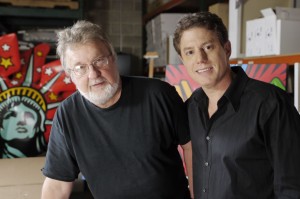Just finished shooting an internet video project with Burton Morris, one of the country’s hottest artists. I love his energetic, vivid, fun style of unique “Pop” art, which is a tribute to artists Andy Warhol and Roy Lichtenstein. Although Burton now resides in L.A., he has family and professional ties to his home town of Pittsburgh, PA. A graduate of Carnegie Mellon University (CMU) Burton started his career as an art director at several major Pittsburgh ad agencies.
Burton Morris has created major works for CocaCola, The Academy Awards, Heinz, the Olympics, Absolut Vodka and hundreds of other corporations. Although he’s an internationally famous artist, Burton Morris’ is also one of the nicest guys you’ll ever meet.
He just completed a fun project for Eat ‘n Park Restaurants. Burton created his own original art to celebrate the 25th anniversary of “Smiley,” Eat ‘n Park’s corporate cookie icon. This summer, Burton Morris’ original artwork will adorn t-shirts, coffee mugs and other items that are sold in Eat ‘n Park’s chain of over 80 restaurants.
Sorry, I can’t reveal Burton’s original “Smiley” artwork, ’till it’s unveiled in June!… stay tuned!


